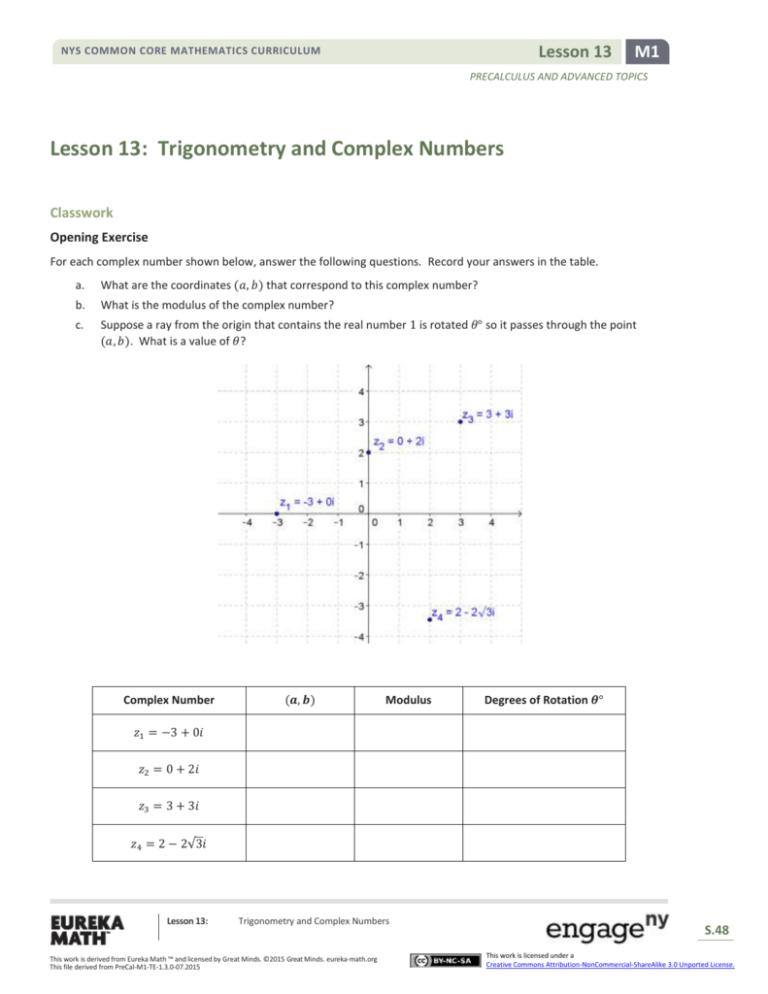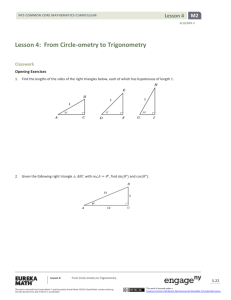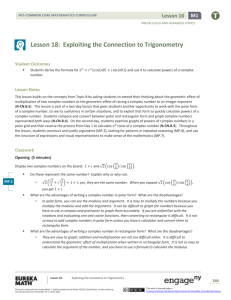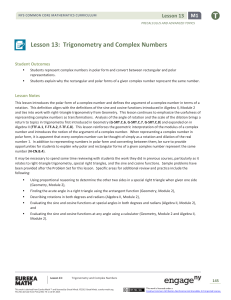Lesson 13: Trigonometry and Complex Numbers
advertisement

Lesson 13 NYS COMMON CORE MATHEMATICS CURRICULUM M1 PRECALCULUS AND ADVANCED TOPICS Lesson 13: Trigonometry and Complex Numbers Classwork Opening Exercise For each complex number shown below, answer the following questions. Record your answers in the table. a. What are the coordinates (𝑎, 𝑏) that correspond to this complex number? b. What is the modulus of the complex number? c. Suppose a ray from the origin that contains the real number 1 is rotated 𝜃° so it passes through the point (𝑎, 𝑏). What is a value of 𝜃? Complex Number (𝒂, 𝒃) Modulus Degrees of Rotation 𝜽° 𝑧1 = −3 + 0𝑖 𝑧2 = 0 + 2𝑖 𝑧3 = 3 + 3𝑖 𝑧4 = 2 − 2√3𝑖 Lesson 13: Trigonometry and Complex Numbers This work is derived from Eureka Math ™ and licensed by Great Minds. ©2015 Great Minds. eureka-math.org This file derived from PreCal-M1-TE-1.3.0-07.2015 S.48 This work is licensed under a Creative Commons Attribution-NonCommercial-ShareAlike 3.0 Unported License. NYS COMMON CORE MATHEMATICS CURRICULUM Lesson 13 M1 PRECALCULUS AND ADVANCED TOPICS Exercises 1–2 1. Can you find at least two additional rotations that would map a ray from the origin through the real number 1 to a ray from the origin passing through the point (3, 3)? 2. How are the rotations you found in Exercise 1 related? Every complex number 𝑧 = 𝑥 + 𝑦𝑖 appears as a point on the complex plane with coordinates (𝑥, 𝑦) as a point in the coordinate plane. In the diagram above, notice that each complex number 𝑧 has a distance 𝑟 from the origin to the point (𝑥, 𝑦) and a rotation of 𝜃° that maps the ray from the origin along the positive real axis to the ray passing through the point (𝑥, 𝑦). ARGUMENT OF THE COMPLEX NUMBER 𝒛: The argument of the complex number 𝑧 is the radian (or degree) measure of the counterclockwise rotation of the complex plane about the origin that maps the initial ray (i.e., the ray corresponding to the positive real axis) to the ray from the origin through the complex number 𝑧 in the complex plane. The argument of 𝑧 is denoted arg(𝑧). MODULUS OF A COMPLEX NUMBER 𝒛: The modulus of a complex number 𝑧, denoted |𝑧|, is the distance from the origin to the point corresponding to 𝑧 in the complex plane. If 𝑧 = 𝑎 + 𝑏𝑖, then |𝑧| = √𝑎2 + 𝑏 2. Lesson 13: Trigonometry and Complex Numbers This work is derived from Eureka Math ™ and licensed by Great Minds. ©2015 Great Minds. eureka-math.org This file derived from PreCal-M1-TE-1.3.0-07.2015 S.49 This work is licensed under a Creative Commons Attribution-NonCommercial-ShareAlike 3.0 Unported License. Lesson 13 NYS COMMON CORE MATHEMATICS CURRICULUM M1 PRECALCULUS AND ADVANCED TOPICS Example 1: The Polar Form of a Complex Number Derive a formula for a complex number in terms of its modulus 𝑟 and argument 𝜃. Suppose that 𝑧 has coordinates (𝑥, 𝑦) that lie on the unit circle as shown. a. What is the value of 𝑟, and what are the coordinates of the point (𝑥, 𝑦) in terms of 𝜃? Explain how you know. b. If 𝑟 = 2, what would be the coordinates of the point (𝑥, 𝑦)? Explain how you know. c. If 𝑟 = 20, what would be the coordinates of the point (𝑥, 𝑦)? Explain how you know. Lesson 13: Trigonometry and Complex Numbers This work is derived from Eureka Math ™ and licensed by Great Minds. ©2015 Great Minds. eureka-math.org This file derived from PreCal-M1-TE-1.3.0-07.2015 S.50 This work is licensed under a Creative Commons Attribution-NonCommercial-ShareAlike 3.0 Unported License. Lesson 13 NYS COMMON CORE MATHEMATICS CURRICULUM M1 PRECALCULUS AND ADVANCED TOPICS d. Use the definitions of sine and cosine to write coordinates of the point (𝑥, 𝑦) in terms of cosine and sine for any 𝑟 ≥ 0 and real number 𝜃. e. Use your answer to part (d) to express 𝑧 = 𝑥 + 𝑦𝑖 in terms of 𝑟 and 𝜃. POLAR FORM OF A COMPLEX NUMBER: The polar form of a complex number 𝑧 is 𝑟(cos(𝜃) + 𝑖 sin(𝜃)), where 𝑟 = |𝑧| and 𝜃 = arg(𝑧). RECTANGULAR FORM OF A COMPLEX NUMBER: The rectangular form of a complex number 𝑧 is 𝑎 + 𝑏𝑖, where 𝑧 corresponds to the point (𝑎, 𝑏) in the complex plane, and 𝑖 is the imaginary unit. The number 𝑎 is called the real part of 𝑎 + 𝑏𝑖, and the number 𝑏 is called the imaginary part of 𝑎 + 𝑏𝑖. General Form Polar Form 𝑧 = 𝑟(cos(𝜃) + 𝑖 sin(𝜃)) Rectangular Form 𝑧 = 𝑎 + 𝑏𝑖 Examples 3(cos(60°) + 𝑖 sin(60°)) 0 + 2𝑖 Key Features Modulus Modulus Argument Coordinate Coordinate Lesson 13: Trigonometry and Complex Numbers This work is derived from Eureka Math ™ and licensed by Great Minds. ©2015 Great Minds. eureka-math.org This file derived from PreCal-M1-TE-1.3.0-07.2015 S.51 This work is licensed under a Creative Commons Attribution-NonCommercial-ShareAlike 3.0 Unported License. Lesson 13 NYS COMMON CORE MATHEMATICS CURRICULUM M1 PRECALCULUS AND ADVANCED TOPICS Exercises 3–6 3. Write each complex number from the Opening Exercise in polar form. Rectangular Polar Form 𝑧1 = −3 + 0𝑖 𝑧2 = 0 + 2𝑖 𝑧3 = 3 + 3𝑖 𝑧4 = 2 − 2√3𝑖 4. Use a graph to help you answer these questions. a. What is the modulus of the complex number 2 − 2𝑖? b. What is the argument of the number 2 − 2𝑖? c. Write the complex number in polar form. d. Arguments can be measured in radians. Express your answer to part (c) using radians. Lesson 13: Trigonometry and Complex Numbers This work is derived from Eureka Math ™ and licensed by Great Minds. ©2015 Great Minds. eureka-math.org This file derived from PreCal-M1-TE-1.3.0-07.2015 S.52 This work is licensed under a Creative Commons Attribution-NonCommercial-ShareAlike 3.0 Unported License. NYS COMMON CORE MATHEMATICS CURRICULUM Lesson 13 M1 PRECALCULUS AND ADVANCED TOPICS e. 5. 6. Explain why the polar and rectangular forms of a complex number represent the same number. State the modulus and argument of each complex number, and then graph it using the modulus and argument. a. 4(cos(120°) + 𝑖 sin(120°)) b. 5 (cos ( ) + 𝑖 sin ( )) c. 3(cos(190°) + 𝑖 sin(190°)) 𝜋 4 𝜋 4 Evaluate the sine and cosine functions for the given values of 𝜃, and then express each complex number in rectangular form, 𝑧 = 𝑎 + 𝑏𝑖. Explain why the polar and rectangular forms represent the same number. a. 4(cos(120°) + 𝑖 sin(120°)) b. 5 (cos ( ) + 𝑖 sin ( )) 𝜋 4 𝜋 4 Lesson 13: Trigonometry and Complex Numbers This work is derived from Eureka Math ™ and licensed by Great Minds. ©2015 Great Minds. eureka-math.org This file derived from PreCal-M1-TE-1.3.0-07.2015 S.53 This work is licensed under a Creative Commons Attribution-NonCommercial-ShareAlike 3.0 Unported License. NYS COMMON CORE MATHEMATICS CURRICULUM Lesson 13 M1 PRECALCULUS AND ADVANCED TOPICS c. 3(cos(190°) + 𝑖 sin(190°)) Example 2: Writing a Complex Number in Polar Form a. Convert 3 + 4𝑖 to polar form. b. Convert 3 − 4𝑖 to polar form. Exercise 7 7. Express each complex number in polar form. State the arguments in radians rounded to the nearest thousandth. a. 2 + 5𝑖 b. −6 + 𝑖 Lesson 13: Trigonometry and Complex Numbers This work is derived from Eureka Math ™ and licensed by Great Minds. ©2015 Great Minds. eureka-math.org This file derived from PreCal-M1-TE-1.3.0-07.2015 S.54 This work is licensed under a Creative Commons Attribution-NonCommercial-ShareAlike 3.0 Unported License. Lesson 13 NYS COMMON CORE MATHEMATICS CURRICULUM M1 PRECALCULUS AND ADVANCED TOPICS Lesson Summary The polar form of a complex number 𝑧 = 𝑟 (cos(𝜃) + 𝑖 sin(𝜃)) where 𝜃 is the argument of 𝑧 and 𝑟 is the modulus of 𝑧. The rectangular form of a complex number is 𝑧 = 𝑎 + 𝑏𝑖. The polar and rectangular forms of a complex number are related by the formulas 𝑎 = 𝑟 cos(𝜃), 𝑏 = 𝑟 sin(𝜃), and 𝑟 = √𝑎2 + 𝑏 2. The notation for modulus is |𝑧|, and the notation for argument is arg(𝑧). Problem Set 1. Explain why the complex numbers 𝑧1 = 1 − √3𝑖, 𝑧2 = 2 − 2√3𝑖, and 𝑧3 = 5 − 5√3𝑖 can all have the same argument. Draw a diagram to support your answer. 2. What is the modulus of each of the complex numbers 𝑧1 , 𝑧2 , and 𝑧3 given in Problem 1 above? 3. Write the complex numbers from Exercise 1 in polar form. 4. Explain why 1 − √3𝑖 and 2(cos(300°) + 𝑖 sin(300°)) represent the same number. 5. Julien stated that a given modulus and a given argument uniquely determine a complex number. Confirm or refute Julien’s reasoning. 6. Identify the modulus and argument of the complex number in polar form, convert it to rectangular form, and sketch the complex number in the complex plane. 0° ≤ arg(𝑧) ≤ 360° or 0 ≤ arg(𝑧) ≤ 2𝜋 (radians) a. 𝑧 = cos(30°) + 𝑖 sin(30°) b. 𝑧 = 2 (cos ( ) + 𝑖 sin ( )) c. 𝑧 = 4 (cos ( ) + 𝑖 sin ( )) d. 𝑧 = 2√3 (cos ( e. 𝑧 = 5(cos(5.637) + 𝑖 sin(5.637)) f. 𝑧 = 5(cos(2.498) + 𝑖 sin(2.498)) g. 𝑧 = √34(cos(3.682) + 𝑖 sin(3.682)) h. 𝑧 = 4√3 (cos ( 𝜋 4 𝜋 4 𝜋 3 𝜋 3 5𝜋 5𝜋 ) + 𝑖 sin ( )) 6 6 5𝜋 5𝜋 ) + 𝑖 sin ( )) 3 3 Lesson 13: Trigonometry and Complex Numbers This work is derived from Eureka Math ™ and licensed by Great Minds. ©2015 Great Minds. eureka-math.org This file derived from PreCal-M1-TE-1.3.0-07.2015 S.55 This work is licensed under a Creative Commons Attribution-NonCommercial-ShareAlike 3.0 Unported License. M1 Lesson 13 NYS COMMON CORE MATHEMATICS CURRICULUM PRECALCULUS AND ADVANCED TOPICS 7. 𝜋 𝜋 𝜋 𝜋 6 4 3 2 Convert the complex numbers in rectangular form to polar form. If the argument is a multiple of , , , or , 𝑏 𝑎 express your answer exactly. If not, use arctan ( ) to find arg(𝑧) rounded to the nearest thousandth, 0 ≤ arg(𝑧) ≤ 2𝜋 (radians). b. 𝑧 = √3 + 𝑖 𝑧 = −3 + 3𝑖 c. 𝑧 = 2 − 2√3𝑖 d. 𝑧 = −12 − 5𝑖 e. 𝑧 = 7 − 24𝑖 a. 8. 9. Show that the following complex numbers have the same argument. a. 𝑧1 = 3 + 3√3𝑖 and 𝑧2 = 1 + √3𝑖 b. 𝑧1 = 1 + 𝑖 and 𝑧2 = 4 + 4𝑖 A square with side length of one unit is shown below. Identify a complex number in polar form that corresponds to each point on the square. Lesson 13: Trigonometry and Complex Numbers This work is derived from Eureka Math ™ and licensed by Great Minds. ©2015 Great Minds. eureka-math.org This file derived from PreCal-M1-TE-1.3.0-07.2015 S.56 This work is licensed under a Creative Commons Attribution-NonCommercial-ShareAlike 3.0 Unported License. NYS COMMON CORE MATHEMATICS CURRICULUM Lesson 13 M1 PRECALCULUS AND ADVANCED TOPICS 10. Determine complex numbers in polar form whose coordinates are the vertices of the square shown below. 11. How do the modulus and argument of coordinate 𝐴 in Problem 9 correspond to the modulus and argument of point 𝐴′ in Problem 10? Does a similar relationship exist when you compare 𝐵 to 𝐵′, 𝐶 to 𝐶′, and 𝐷 to 𝐷′? Explain why you think this relationship exists. 12. Describe the transformations that map 𝐴𝐵𝐶𝐷 to 𝐴′𝐵′𝐶′𝐷′. Lesson 13: Trigonometry and Complex Numbers This work is derived from Eureka Math ™ and licensed by Great Minds. ©2015 Great Minds. eureka-math.org This file derived from PreCal-M1-TE-1.3.0-07.2015 S.57 This work is licensed under a Creative Commons Attribution-NonCommercial-ShareAlike 3.0 Unported License. Lesson 13 NYS COMMON CORE MATHEMATICS CURRICULUM M1 PRECALCULUS AND ADVANCED TOPICS General Form Polar Form 𝑧 = 𝑟(cos(𝜃) + 𝑖 sin(𝜃)) Rectangular Form 𝑧 = 𝑎 + 𝑏𝑖 Examples Key Features Modulus Modulus Argument Coordinate Coordinate Examples Key Features Modulus Modulus Argument Coordinate Coordinate Examples Key Features Modulus Modulus Argument Coordinate Coordinate Lesson 13: Trigonometry and Complex Numbers This work is derived from Eureka Math ™ and licensed by Great Minds. ©2015 Great Minds. eureka-math.org This file derived from PreCal-M1-TE-1.3.0-07.2015 S.58 This work is licensed under a Creative Commons Attribution-NonCommercial-ShareAlike 3.0 Unported License.










